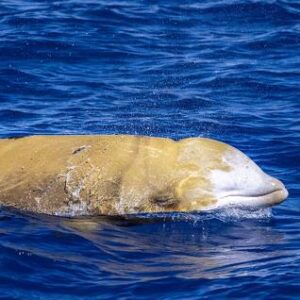
Early in the morning of Oct. 17, a 4.85m (15.9 ft) long Cuvier’s beaked whale (Ziphius cavirostris) was seen “thrashing” about in the water in Fish Bay, St. John. Construction workers who were near the site saw it swim out of the bay, but shortly afterward observed it drifting back. The construction team notified Lila Uzzell, a UVI Masters in Marine and Environmental Science student.
Uzzell reported the whale to the National Marine Mammal Stranding Network, which referred it back to the Virgin Islands Division of Fish and Wildlife within the V.I. Department of Planning and Natural Resources. Upon hearing the report, UVI Center for Marine and Environmental Studies (CMES) Director Paul Jobsis, Ph.D., requested that UVI perform the necropsy and use the skeleton as an educational display.
UVI Center for Marine and Environmental Studies employees, and UVI alumni Nicolas Durgadeen and Sam Gittens were conducting coral reef studies near Fish Bay that morning with Captain Kevin McCartney. Having received approval from local and national agencies, Jobsis requested McCartney tow the small whale to the UVI dock in Brewers Bay. Following four hours of towing, the whale reached the dock at 5 p.m. on Oct. 17, where a small crowd of UVI students and employees were waiting to photograph the whale and measure all body dimensions.
Jobsis assembled the team to begin the necropsy the next morning. “It is sad that this amazing animal died, but it is an incredible opportunity to learn more about them,” said Jobsis. “Beaked whales are rarely seen at the surface and are some of the deepest diving mammals in the world. They are known to dive down to 9,800 feet and hold their breath for nearly four hours. That’s incredible.”
According to the National Oceanic and Atmospheric Administration (NOAA) information webpage on Cuvier’s beaked whales, they are known to dive to 9,816 feet, and the longest recorded dive lasted 222 minutes. Typically, they dive to 3,300 feet for approximately an hour at a time. These whales live in small groups of two to seven animals and feed on deep-dwelling squid and octopus. The females have no teeth, and the males have two teeth jutting out of the lower jaw and two tiny teeth in the upper jaw. The animals suck in their prey and swallow them whole.
On the morning of the 18th, the necropsy team, Dr. Donna Nemeth, veterinarian; Dr. Heidi Stout; Moriah Bass, MSc; Amber Packard, MSc, and several UVI students started collecting samples to learn from this rare opportunity.
“Blubber (fat) samples taken from near the head, body and tail (flukes) will be sent to labs at the National Marine Fisheries Southeast Office to determine the health, possible cause of death and confirm the species identification,” said Jobsis.
Samples were also taken for analysis by beaked whale experts like Kristie West, Ph.D. The whale is a young adult male, and Jobsis hopes they will be able to confirm if it were sexually mature, as it is smaller than previously reported adult Cuvier’s beaked whales.
“We don’t know for sure what killed the animal; there were no obvious wounds that you would expect from a being hit by a ship. The animals are known to be sensitive to military mid- and low-frequency sonar. The sound damages their ears, and they swim too fast to the surface and get the bends. We didn’t find any food in its stomach but have taken stool samples of some parasites from its kidneys,” said Jobsis.
The necropsy was finished by Oct. 19. At that point, the team had removed most of the blubber and meat and towed it all far offshore to be released. The skeleton was sunk temporarily and will be recovered for use as an educational display.
“I know there are some people worried about the possibility of the carcass attracting sharks to Brewers Bay, but that is not likely because most of the meat is gone and the carcass is not near any swimming areas,” said Jobsis. “The flippers have already been removed and cleaned. When the skeleton is recovered, the long process of bleaching and reassembly begins. It is going to make an amazing display that hopefully inspires students to learn more about the oceans and the animals in it.”





